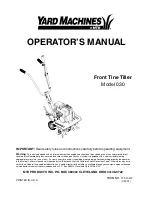
T
HERMO
C
UBE
200/300/400
T
HERMOELECTRIC
C
HILLER
M
ANUAL
52-11300-1
S
OLID
S
TATE
C
OOLING
S
YSTEMS
,
167
M
YERS
C
ORNERS
R
OAD
,
W
APPINGERS
F
ALLS
,
NY
12590
33
T
ELEPHONE
:
(845)
296-1300
F
AX
:
(845)
296-1303
WEB
:
WWW
.
SSCOOLING
.
COM
V
ERSION
M28
Skin Contact:
Minor skin irritation and penetration may occur.
Eye Contact:
Splashes may cause irritation, pain, and eye damage.
Chronic Exposure:
Repeated small exposures by any route can cause severe kidney problems. Brain damage may also occur.
Skin allergy can develop. May damage the developing fetus.
Aggravation of Pre-existing Conditions:
Persons with pre-existing skin disorders, eye problems, or impaired liver, kidney, or respiratory function
may be more susceptible to the effects of this substance.
4.
F
IRST
A
ID
M
EASURES
Inhalation:
Remove to fresh air. If not breathing, give artificial respiration. If breathing is difficult, give oxygen. Call a
physician.
Ingestion:
Induce vomiting immediately as directed by medical personnel. Never give anything by mouth to an
unconscious person. Get medical attention.
Skin Contact:
Remove any contaminated clothing. Wash skin with soap and water for at least 15 minutes. Get medical
attention if irritation develops or persists.
Eye Contact:
Immediately flush eyes with plenty of water for at least 15 minutes, lifting lower and upper eyelids
occasionally. Get medical attention immediately.
Note to Physician:
Give sodium bicarbonate intravenously to treat acidosis. Urinalysis may show low specific gravity,
proteinuria, pyuria, cylindruria, hematuria, calcium oxide, and hippuric acid crystals. Ethanol can be used
in antidotal treatment but monitor blood glucose when administering ethanol because it can cause
hypoglycemia. Consider infusion of a diuretic such as mannitol to help prevent or control brain edema and
hemodialysis to remove ethylene glycol from circulation.
5.
F
IRE
F
IGHTING
M
EASURES
Fire:
Flash point: 111C (232F) CC
Autoignition temperature: 398C (748F)
Flammable limits in air % by volume:
lel: 3.2; uel: 15.3
Slight to moderate fire hazard when exposed to heat or flame.
Explosion:
Above flash point, vapor-air mixtures are explosive within flammable limits noted above. Containers may
explode when involved in a fire.
Fire Extinguishing Media:
Dry chemical, foam or carbon dioxide. Water or foam may cause frothing. Water spray may be used to
extinguish surrounding fire and cool exposed containers. Water spray will also reduce fume and irritant
gases.







































